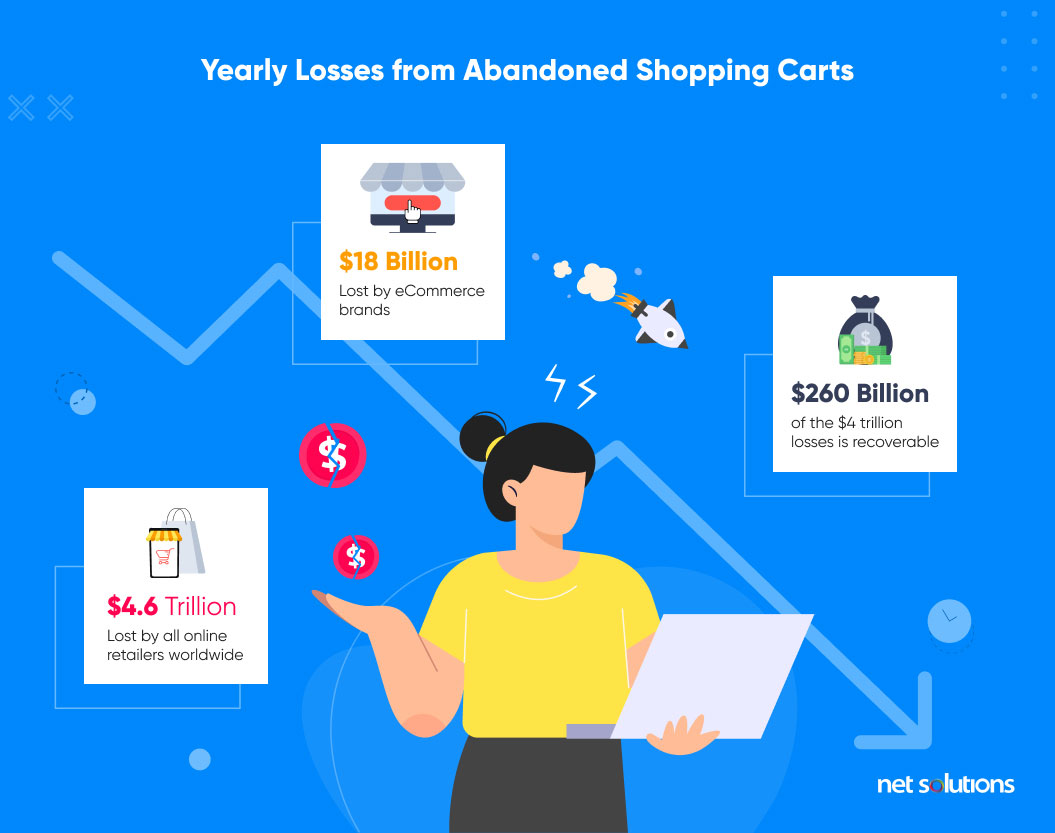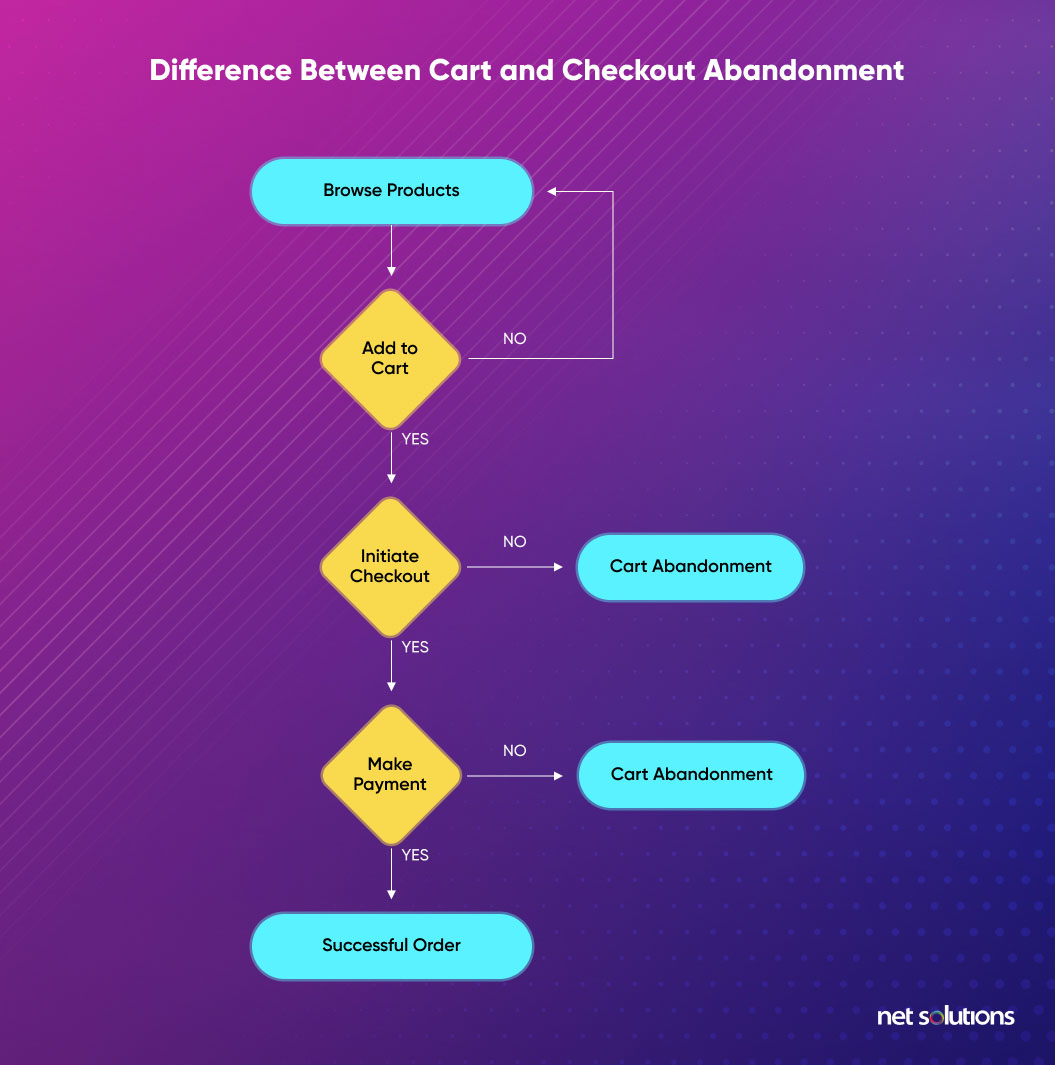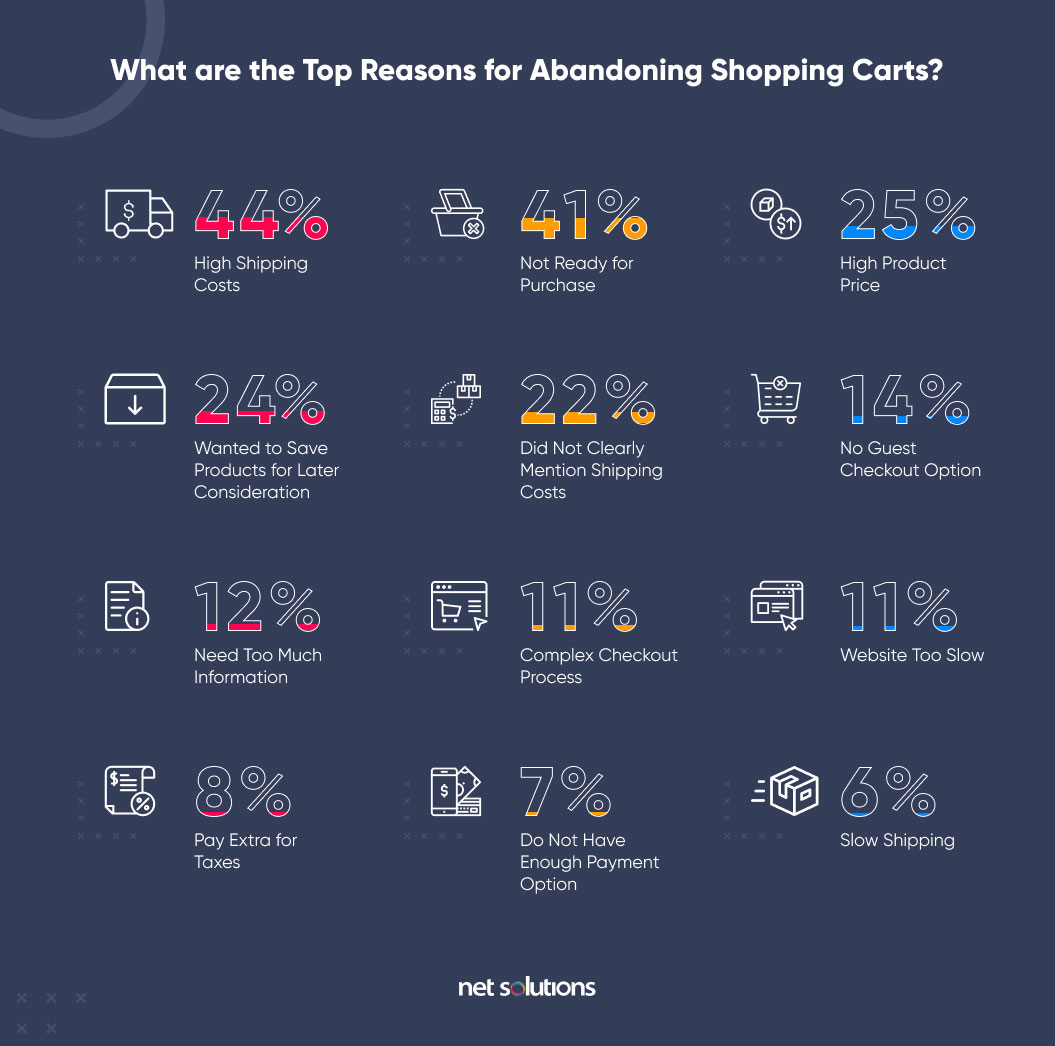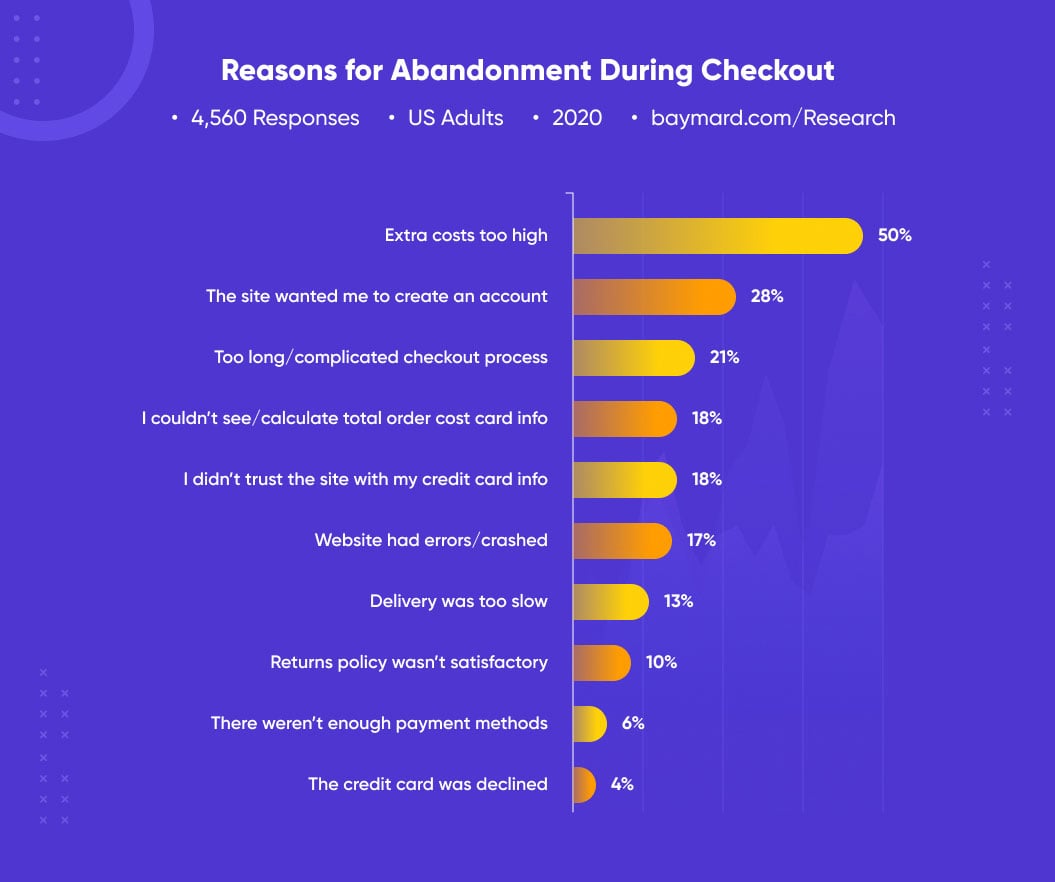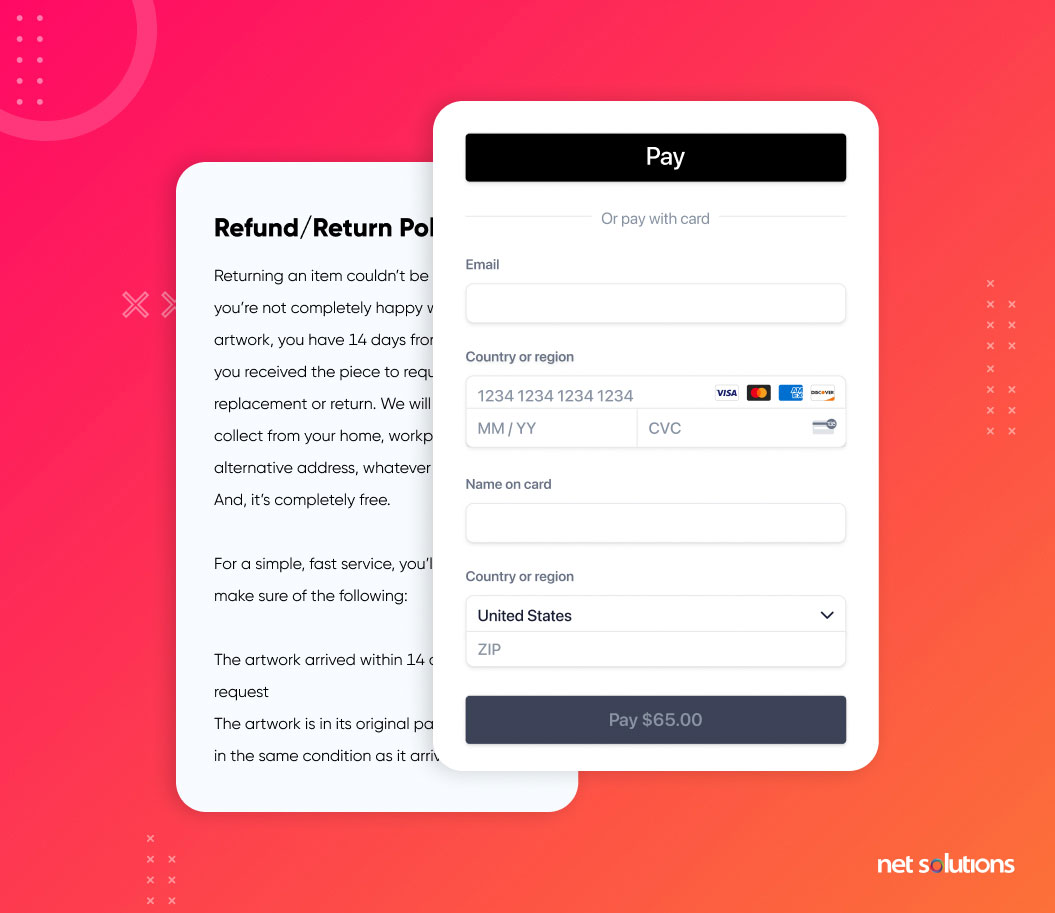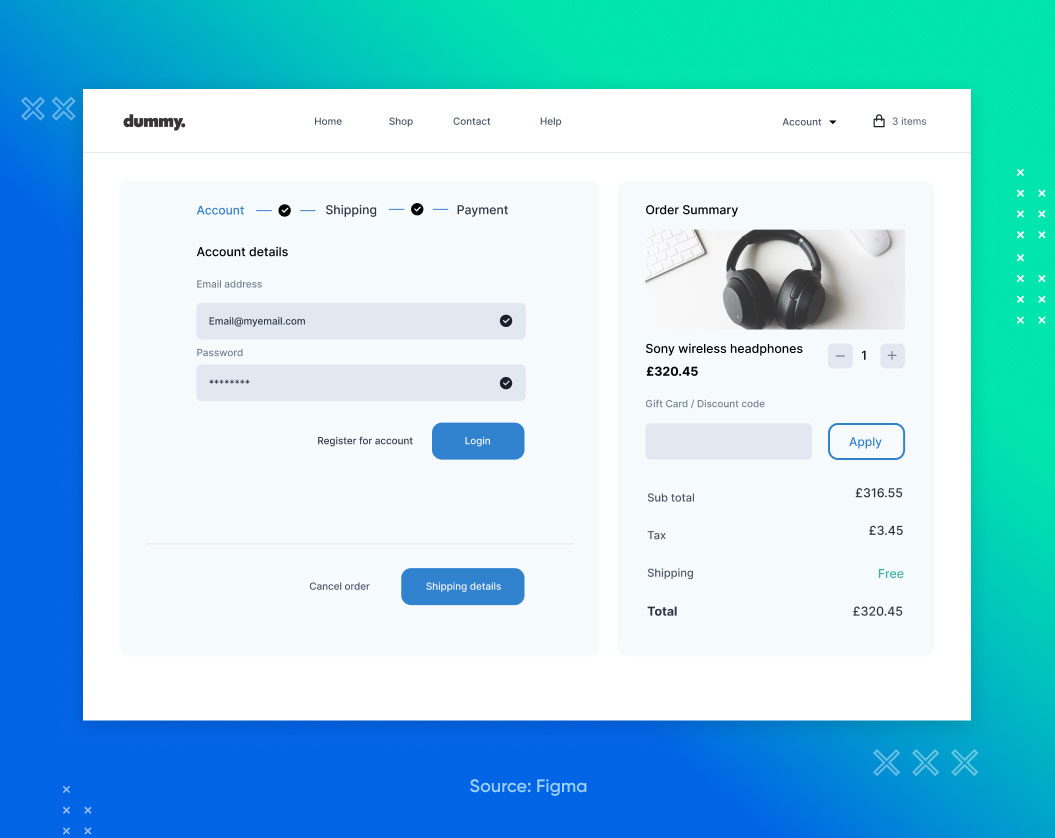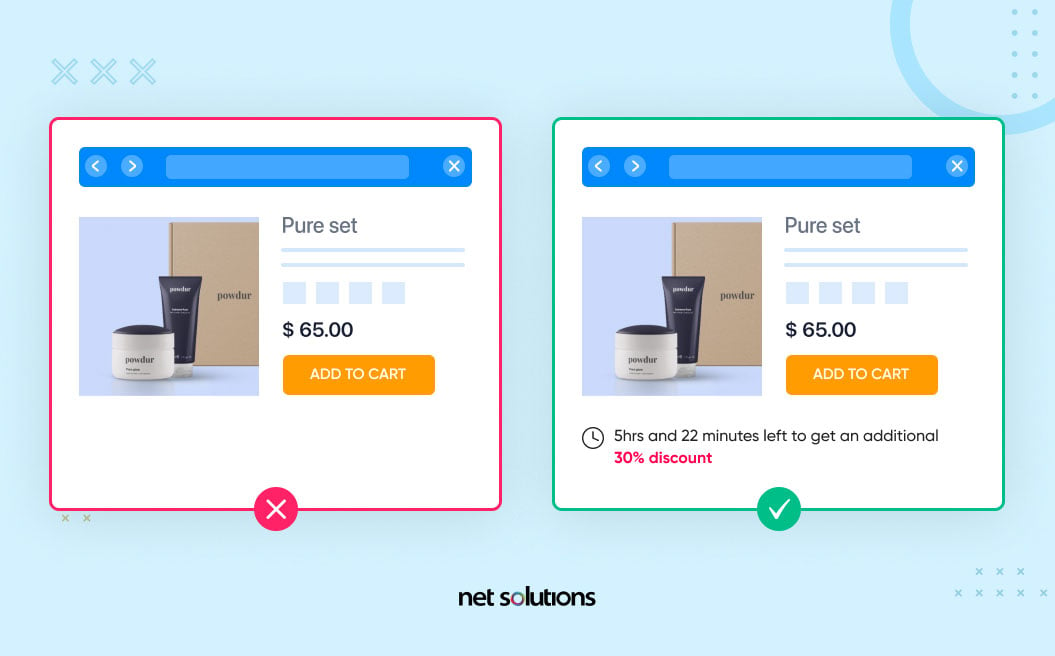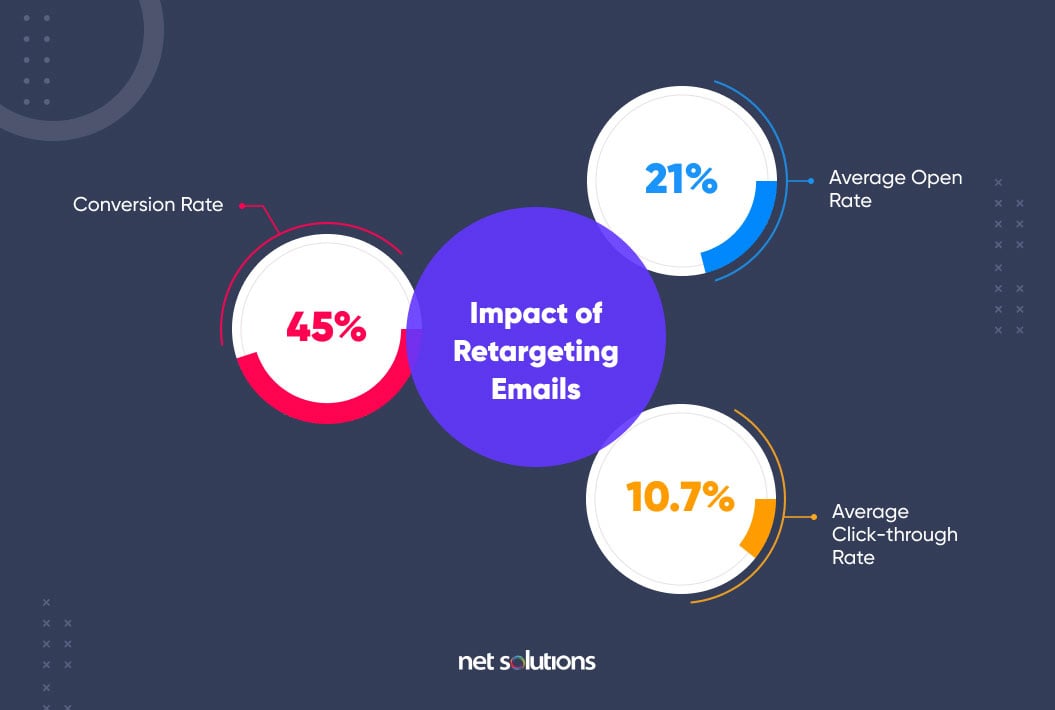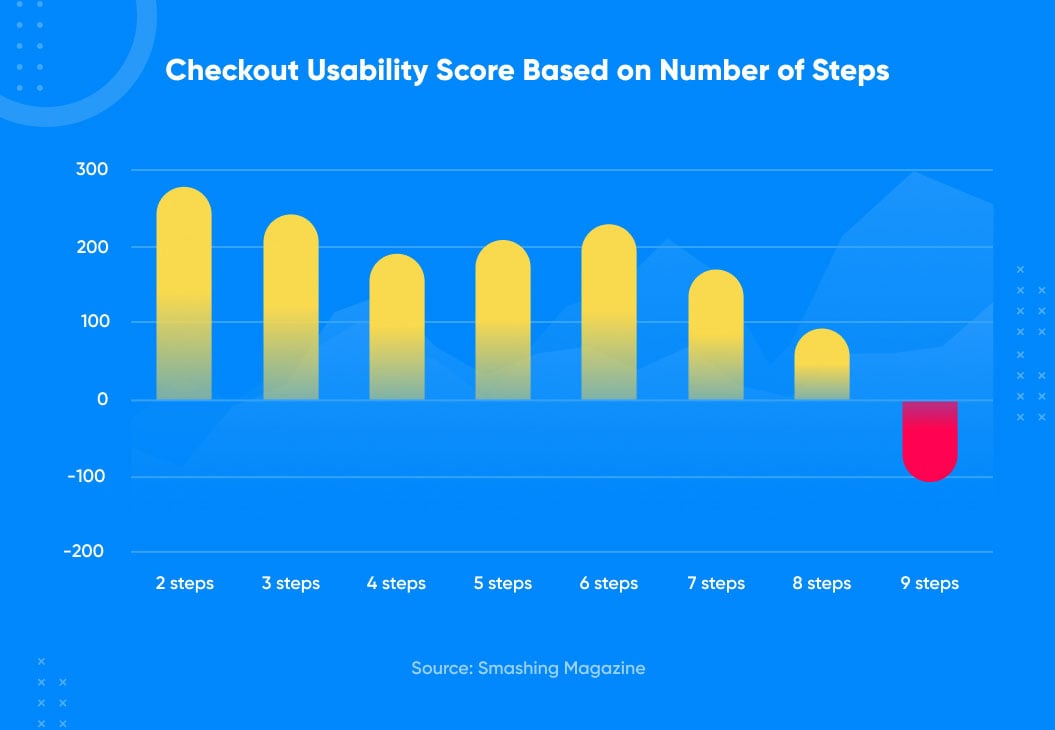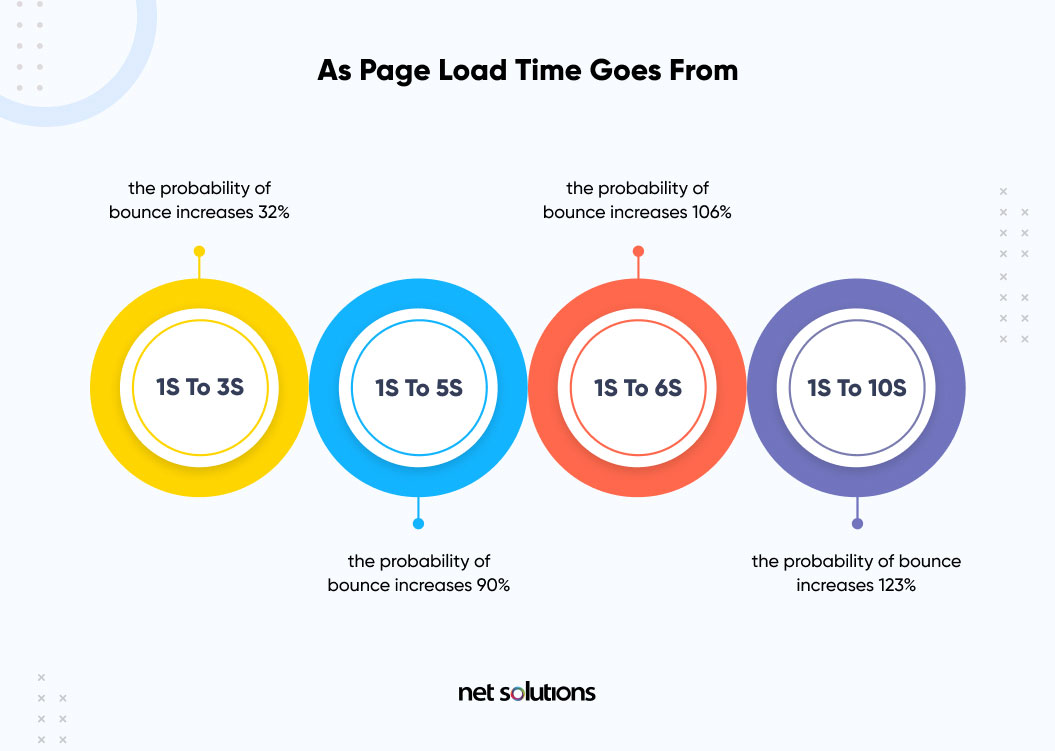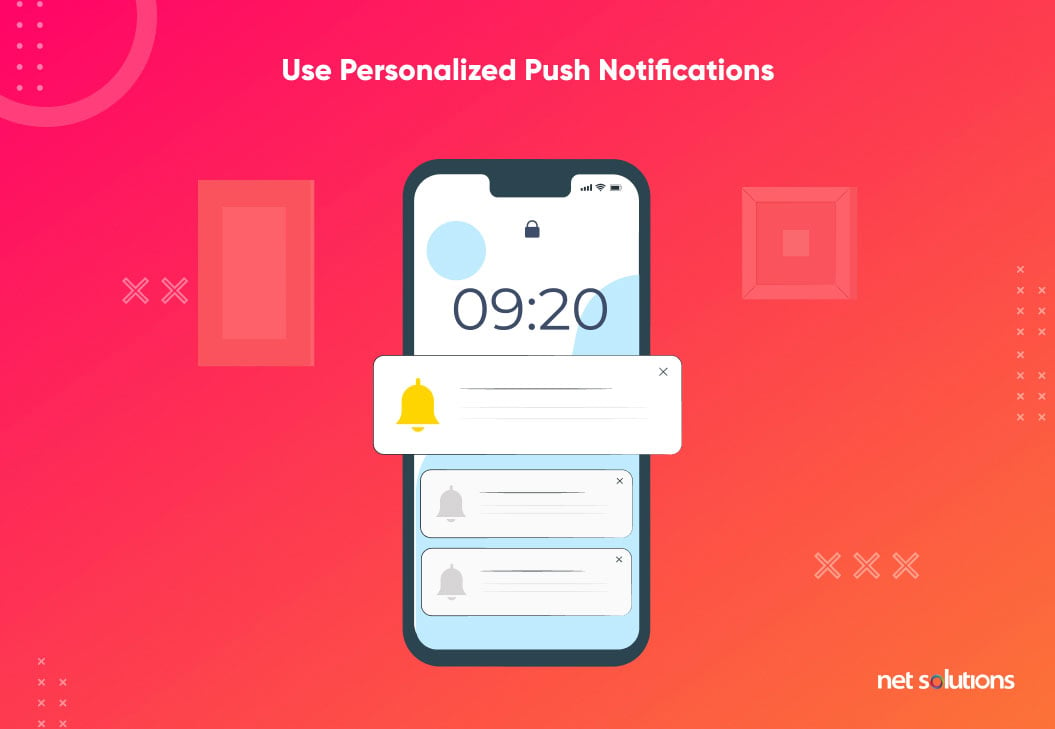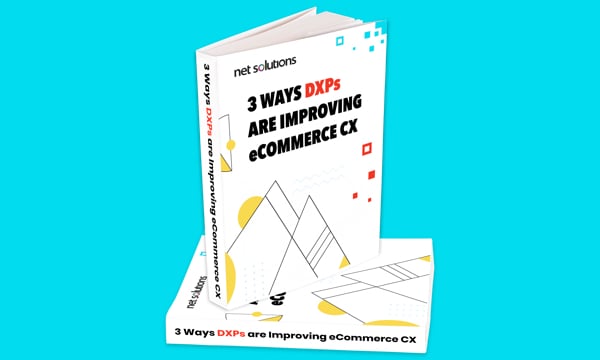Jeff starts an eCommerce business that sells clothes. He puts all his blood and sweat into creating the platform, designing it, creating back-end support, integrating payment options, and everything else that it takes to make an eCommerce platform work. Many customers visit his website, but only a few complete their purchases, which surges the shopping cart abandonment rate.
This is one bitter truth that Jeff learned the hard way but will eventually have to form his strategy around reducing such halfway abandonments. However, this isn’t some random issue that can be ignored. If you believe your eCommerce business is untouched by this phenomenon, you are just creating a mental block in your head that will lead you nowhere but to downfall!
Unfortunately, the fact is- whether you list a hundred products or thousands of them, you can’t force customers to complete what they started.
But, you can at least mend the gap by stopping to put all your eggs in one basket.
And we are going to discuss the most trusted and practiced options highly effective in reducing shopping cart abandonment.
eCommerce cart abandonment is a reality that affects every industry nowadays. Let’s take a look at shopping cart abandonment statistics for 2021 by fundera:
- 69.57% is the average documented eCommerce cart abandonment rate.
- 35.26% increase in conversion rate through better checkout design.
- $260 billion are recoverable through checkout improvements.
- 85.6% is the average mobile eCommerce cart abandonment rate.
- 55% of online shoppers abandon their cart because extra costs were too high.
- At 87.87%, airline cart abandonment rates are the highest.
What is Shopping Cart Abandonment?
Shopping cart abandonment is when a potential customer adds items to their shopping cart but leaves before purchasing. Any item added to the shopping cart but never makes it through the transaction is considered “abandoned” by the buyer. Shopping cart abandonment is a critical aspect of the online shopping process that retailers pay careful attention to.
Why is Online Shopping Cart Abandonment a Problem for Retailers?
Cart Abandonment is often a very common and inevitable part of the purchasing journey. It wouldn’t be entirely possible to remove the abandonment process. However, retailers can optimize the checkout process and provide the best customer experience possible to reduce the abandonment problem.
Regaining even a small portion of abandoned transactions can yield significant profit in revenues for businesses. While there are methods to abstract the transaction left midway, like retargeting ads or recovery reminder emails, your best bet is saving the sale before shoppers leave your website. On a global scale, cart abandonment costs retailers $4.6 trillion a year. And an estimated $260 billion is recoverable.
Mobile devices witnessed higher Cart abandonment rates. The data below from Barilliance shows a rate of 73% on desktops, 80.7% on tablets, and a huge 85.6% on mobile phones.
However, optimizing the checkout process can help sites boost conversions by a significant ratio. We’ll look at some of those digital commerce optimization methods later in this article.
Online Shopping Cart Abandonment and Checkout Abandonment: What’s the Difference?
Here is a simple and straightforward example to help you understand what is cart abandonment and how it is different from checkout abandonment or checkout drop-off.
Step 1
Suppose visitors arrive on your custom eCommerce platform and start browsing. In case the visitors are your old customers, the recommendation engine would suggest products based on their interests. So far, so good.
Step 2
They like something and add the product to the cart, but for one reason or another, drop out before they move ahead with the payment. That is shopping cart abandonment.
Step 3
On the other hand, if visitors choose to go to the checkout page and initiate the checkout, they are likely to make the purchase. But, if they drop out after the initiation of the payment process, it is known as checkout abandonment.
In either case, the common factor is that the conversion rate suffers. It is a loss-loss scenario in both cases.
What are the Top Reasons for Abandoning Shopping Carts?
To get a broader understanding of why shopping cart abandonment is a problem for retailers and what are the reasons behind it, you need to understand your customer persona and business processes thoroughly.
It is essential to understand the customer’s psychology and mindset when they make a purchase, i.e., what turns them off and what leads to a successful transaction.
Here are some of the top reasons why customers abandon their carts:
1. Extra Costs Too High
Nobody wants to pay extra. And that’s why it is one of the most common reasons for customers abandoning shopping carts. Additional costs always make customers rethink their purchase.
2. Mandatory Account Creation
Compelling your users to create an account for making a purchase is always a bad idea that will lead to cart abandonment. Some users are too lazy to create an account, which will turn them away.
3. Complicated Checkout Processes
When setting up your eCommerce website’s checkout flow, remember every added step and form field restricts the users to make a payment. That’s why it is advisable to always keep your checkout process as simple as possible.
While the above-listed were just the top three reasons, there are some other reasons as well behind why customers abandon shopping carts.
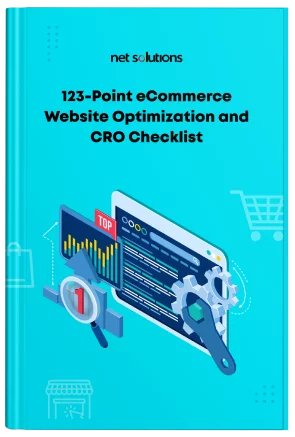
We respect your privacy. Your information is safe.
What are the Ways to Reduce eCommerce Cart Abandonment?
Every eCommerce store is different, and will be built on it own ecosystem of ecommerce solutions. Meaning thereby that the way of reducing checkout abandonment action will also vary. We will discuss some of the most critical yet easy-to-implement strategies for online retailers.
1. Eliminate the Surprise Costs All at Once
The hidden costs that add up to the final cart value can be related to the psychological phenomenon of “pain of paying.” People don’t like spending money, and when the cost is much, they tend to avoid making the payment irrespective of the need for the product.
How to address this issue:
a. Price Calculator Tool
Embedding a price calculator tool on the product page or the cart page can be helpful. Include all factors such as taxes and shipping fees as parameters for the calculation. This way, shoppers do not feel like profit-making machines. Instead, they feel informed and valuable.
b. Setting Shipping Thresholds
Offering free shipping in turn of a particular cart value should be considered. Even if you are offering percentage discounts, the need to reduce shipping costs is equally beneficial. And, the thing to remember is that the free shipping threshold should fall under a reasonable bracket.
c. The Best-Price Criteria
Shoppers are savvy these days. They tend to compare prices on different eCommerce platforms before making the final purchase. So, the best strategy is to offer the best price that is cheaper than what others are offering.
Businesses concerned about the shopping cart abandonment rate the most are because it lowers conversions, and eliminating all the surprise costs will surely help you reduce the same.
2. Account Creation is Mandatory – Really? But, Why?
Think of it this way; if you were a brick-and-mortar store owner, would you ask everyone entering the store who they are. No, right? Then, why make it an obligation on the eCommerce store? It does not make much sense. Letting visitors choose between registering or not registering is essential to eliminate the B2C or B2B eCommerce website cart abandonment rates. If you do not do that, they will add to the cart but will leave halfway.
Here is how to address online cart abandonment by solving this issue:
a. Offer Guest Checkouts: Let visitors complete their purchase without having to create an account. Your checkout flow should go the way your visitors expect it to be, and you shouldn’t force them to do anything unnecessarily.
b. Social Logins: Another great strategy to work in your stride is to incorporate social logins. Be it Google login, Facebook login, or the newly introduced Apple login, these options add convenience, lessen the registration form fields, and take away the burden of manually entering user information time and again.
3. Building Trust Among the Customers
Transaction forms are one of the essential tools in establishing and building trust in your site.
You ask your customers to trust you with their personal information — this goes far beyond just their contact details; asking for credit or debit card details is something many people are (reasonably) hesitant to part with. At this point, while your customer is hesitant to share details of their hard-earned money, use this as an opportunity to build trust.
Here, Security logos and certifications act as trust signals. They indicate eCommerce security, a critical factor for any shopper to buy from a website.
- 61% of consumers had not purchased something online because trust logos were missing.
- More than 75% of consumers had chosen against purchasing because they didn’t recognize the trust logos.
Creating a Constructive Return and Refund Policy
A vital tactic of establishing and retaining trust during the financial process is building a robust return and refund policy for eCommerce.
It helps in retaining the dedicated customer group for future shopping and naturally reduced cart abandonment issues. Since online shopping doesn’t provide the luxury of trying the product in person before the item is delivered, offering a good return and refund policy provides a sense of security before making the purchase. It is also essential to present the refund and return policies early during the checkout process to help customers make an informed decision.
4. Including Thumbnail Images of Products Throughout the Checkout Process
Including Thumbnail images of products throughout the checkout process reassures about the “selected” item. Thumbnail images work as a grounding technique and connect the customer with the item to be purchased. These images help eliminate the possibility of distraction, primarily when the customer is hesitant to complete the purchase if they immediately can’t remember what they’re going to buy.
The checkout page above is a proper illustration of how it serves as a cart abandonment solution. This page includes the shipping, checkout, and the small yet easily identifiable thumbnail of the product in the customer’s shopping cart. This is a less intimidating and hassle-free checkout experience.
5. Effortless Navigation Between the Shopping Cart and Checkout Process
Shopping can be indirect, inefficient, and far from linear, especially in online stores. It’s rare to quickly pick an item, selecting it, and making the purchase. The better the customer experience during the buying journey, the more chances the customer will make a purchase. A better customer experience reduces the friction of completing the transaction to a reasonable extent.
However, it’s challenging to make the process seemingly inefficient. Leading online stores like Amazon are also constantly experimenting with straightforward navigation, the checkout flow & experience so that more customers complete the transaction.
Remember, the more work you force your prospective customers to do, the less likely they are to cross the line and convert.
6. Include a Strong Call to Action on Checkout Pages
Several eCommerce businesses overlook the importance of strong “call-to-actions” on the checkout pages. On the contrary, including “CTA’s” on the checkout pages are one of the best options for strengthening the prospect and motive of completing the purchase.
If the CTAs tone appears inconsistent in the checkout pages to visitors, it might disrupt the seamless experience you aim to provide. Thus apart from making the CTA message “strong” and “conversational,” it should also maintain a straightforward and clear tone to avoid confusion.
Various B2C or B2B eCommerce platforms will offer their set of feature combinations for a unique design experience. Magento platform, for example, offers a platter of useful features that can help control the look, content, and functionality of the particular online store – without compromising the shopping experience.
7. Retargeting Email is a Thing Now
When online shoppers leave abruptly, it is a saddening thing. But, sometimes, they can be forgetful. Like they went for dinner and forgot to proceed with the checkout process. You’ll never know what went wrong. But, you could take your chances and remind them that they need to complete what they started. Chances are they’ll get back to you because you remembered them. It is the human touch a business needs to offer.
According to Moosend, retargeting emails show significant results. Here are the stats that say so.
What should these emails be like? Here are some abandoned shopping cart email best practices:
a. Work on the Subject Line: A study by Convince and Convert says that 35% of people click on the mail based on the subject line alone. You need to craft something enticing and to the point. Examples could be something such as “Stock availability is low, hurry!”, “Did you forget something,” or “We have reserved this pair of shoes for you! Make them yours.”
b. Calculated Mail Series: Sometimes, the first mail is more than enough and does the magic, but if it is time for holidays, and they are busy, sending 2-3 follow-up emails will not harm much. You could also create urgency in these emails through “low stock” alerts and ask them to act soon. But, remember not to act too desperate.
c. Catchy Graphics is All it Takes: Be as creative as you can when designing these emails to decrease shopping cart abandonment. Add unique graphics one can’t ignore scrolling through.
The intent is simple; if the email gets opened, the shopper can’t resist buying because your mail stands out from the hundreds they receive every day.
8. Restrict the Checkout Process to 4-5 Steps
The checkout process can be long and tiring sometimes. The more you try to extract information from the customer’s end, the more they get frustrated and lose interest. Imagine a salesperson calls you and tries to sell you their credit card. You agree to buy it, but when they start adding clauses and keep on bugging you with questions, you prefer hanging up. This can be one reason why online shopping cart abandonment occurs.
Here’s the usability score based on the number of steps added.
So, what to do about it?
a. Progress Indicators: Maintaining a linear checkout process should top your priority list. That is, a straight and streamlined process should be followed from start to finish. The step-by-step progress indicators make them track where they are heading. But, again, keep these steps minimal and do not make it a rabbit trail.
b. Animated Graphics: Data visualization is always welcome. While a visitor goes to the cart, you can add animated graphics at each step of the process to make it an exciting journey. These graphics can also help compensate for the loading times by keeping the visitors engaged.
9.Chatbots for Instant Support
What if a visitor wants to buy something but they have some confusion or doubts? Usually, they’ll send an email or even call your customer support, but the delayed and extended response time might force them to leave a cart. The good thing is that there are chatbots these days to fill in the void.
So, how to reduce the cart abandonment rate with the help of Chatbots? Here are some tips:
a. Embedding Messenger Bots: Having a messenger bot such as Facebook can surely add to the sales. 71% of users are willingly ready to use messengers for customer service. Thus, having one tends to be a great opportunity in hand for eCommerce platforms when dealing with increasing shopping cart abandonment rates.
b. Build Shopping Assistants: Let’s unburden the visitors by letting the bots do all the needful. Traditionally the visitors browse for the product they are looking for before adding it to the cart. However, this might take some time. So, build a bot that asks them what they want and guides them through. This delivery of the right content at the right time is one good reason that a purchase would happen.
10. Keep an Eye on Intuitiveness & Design
There can be times when a visitor decides to make a purchase, but finding the “Add to Cart” button becomes tricky. On the other hand, there can be times when a visitor is only browsing but finds it problematic to locate the “Save for Later” option and instead adds it to their carts. In either case, the UX design is at fault, and it needs to be fixed for better conversions.
About $260 billion in lost eCommerce sales could be recovered through checkout optimization. – Baymard Institute
But, how to go about abandoned cart recovery?
a. Easy Navigation: Make the landing page easy to navigate through. Every element needs to be designed in a way that it dominates the screen. Be it an on-site search option, add to cart, or save for later, every element should be visibly distinguishable so that one’s intent and actions stay in harmony.
b. Easy Cart Alteration: Sometimes, the visitor can mistakenly add more items to the cart than required, or vice-versa. It should be made convenient to add/delete items in the cart without much hassle. Otherwise, the broken user experience will lead to an increased shopping cart abandonment rate.
c. Color Combinations: The “Add to Cart” CTA and the “Save for Later” CTA needs to have different & dominant color backgrounds. In short, a consistent and logical visual hierarchy should be maintained throughout the platform.
d. Keep Accessibility in Mind: Designing your eCommerce website keeping visitors with disabilities in mind can also reduce cart abandonment rates to a great extent. It’s because many disabled shoppers visit eCommerce websites, but 65% of them abandon a purchase due to poor eCommerce website accessibility. So, chances are that a small portion of cart abandonment rates on your website are from these people.
By making your eCommerce website accessible, you can offer these users a positive experience and decrease your cart abandonment rates.
To create accessible eCommerce website designs:
- Use alternative text in all the product images.
- Don’t add links where it doesn’t make sense.
- Use actions or transcripts in videos to ensure people with disabilities can understand them.
- Make your content easy to read and understand.
Various eCommerce platforms will offer their set of feature combiantions for a unique design experience. Magento platform, for example, offers a platter of useful features that can help control the look, content and functionality of the particular online store – that too, without compromising on the shopping experience.
11. Mobile Page Load Times Can’t be Missed
Mobile page load time is an essential criterion that counts when converting a visitor into a customer. A study by Google revealed something alarming about mobile page speeds and respective bouncing rates. See it for yourself.
In short, faster is better to eliminate the probability of shopping cart abandonment.
But how to optimize mobile performance?
a. Embrace Material Design: The most prominent reason behind slow loading speed is the large size of the graphics and other content on the page. That is why implementing Material Design, a popular UX design trend, is a good practice. Also, compressing images and text should be made a priority. Again, according to Google, 25% of pages could save more than 250KB, and 10% can save more than 1MB that way.
b. Take Advantage of Your eCommerce Platform: The digital eCommerce platform you choose also plays a significant role in deciding the mobile page load speed. Like Magento uses “Full Page Cache” on the server to quickly display various pages. Or, in case you choose Shopify over Magento, its RocketAMP app helps improve mobile page loading speed.
12. Use Personalized Push Notifications
Today, customers need a personalized experience at every step of their journey. If used the right way, push notifications can do wonders in lessening the cart abandonment rate.
For example, a customer has some products in a cart, and he forgets about placing the order due to any reason. You can send him a customized push notification having his name and product developments in the cart with some discount offer (if you have any). This will help your brand build a connection with the customer, leading to more sales.
Let’s see what these push notification should look like:
a. Showcase Empathy: The most significant factor that contributes to continued sales is empathy. You need to be listening to your customers and helping them at every stage of the buyer journey. Often, eCommerce retailers oversee the pain points, which further leads to a bad customer experience.
You can use push notifications as a salesperson to avoid high cart abandonment rates and to give your customers an experience that they will never forget. Make it your USP, and you’ll see an overall improvement in how your brand fairs in comparison to your competition.
b. Give them Discounts: Giving deals and discounts may take away some of your revenue, but this strategy improves your conversions. After all, who doesn’t love a discount? If you combine a bit of personalization with a 20% discount offer, you can see your sales grow in just a few days.
Conclusion
So that was all about how to avoid the shopping cart abandonment rate.
Building an exceptional shopping experience takes effort. Do not miss this opportunity, as it can help redeem what is lost. To be concise, you only have to worry about one thing; creating an experience that your visitors and existing customers would love.
And, it is not that your eCommerce shopping cart abandonment rate will come down to zero immediately, but your effort towards successful conversions should not come to a halt. The trick is never to stop making things better for your business and your customers.
Start with A/B testing the above techniques, keep what works, and discard the rest.
You can even seek assistance from industry experts as their knowledge and experience can help you stay ahead of the curve in this competitive e-retail landscape.
Try.Test.Engage.Convert.Repeat!


